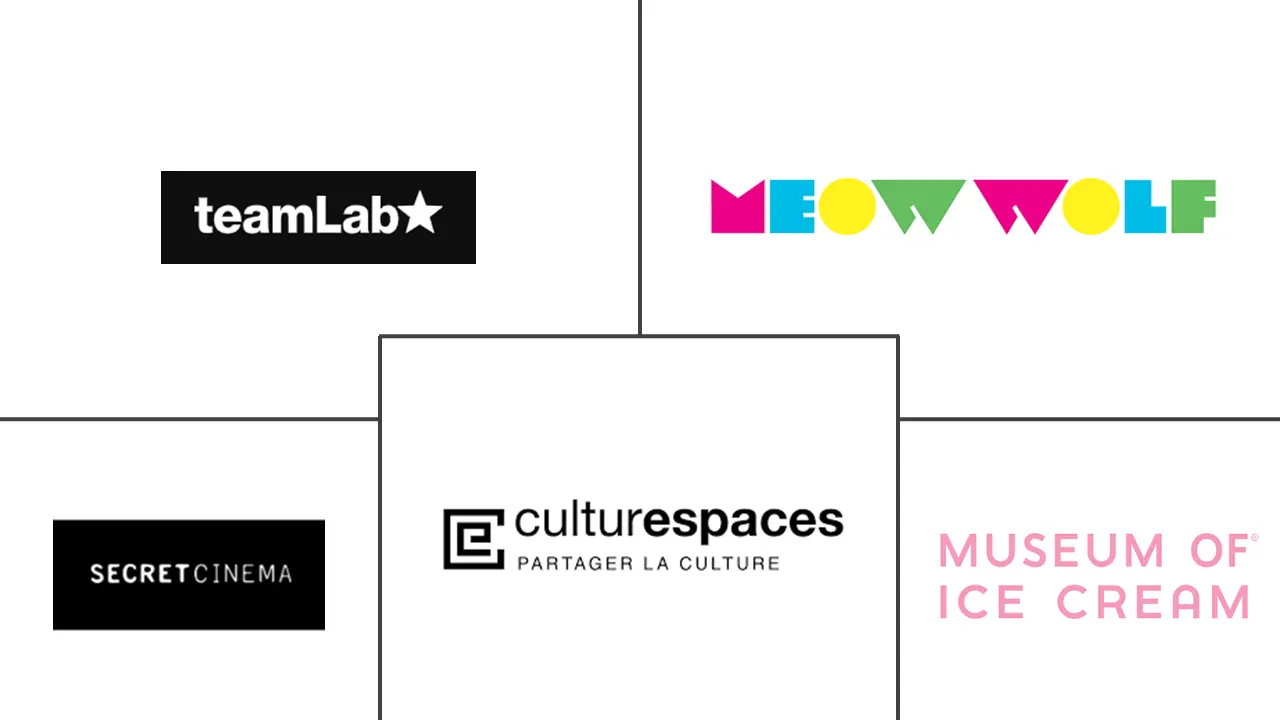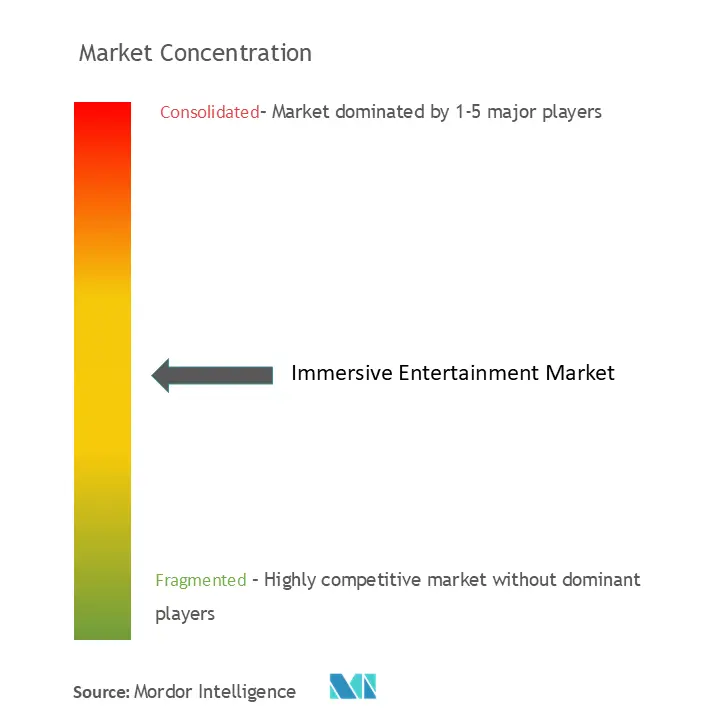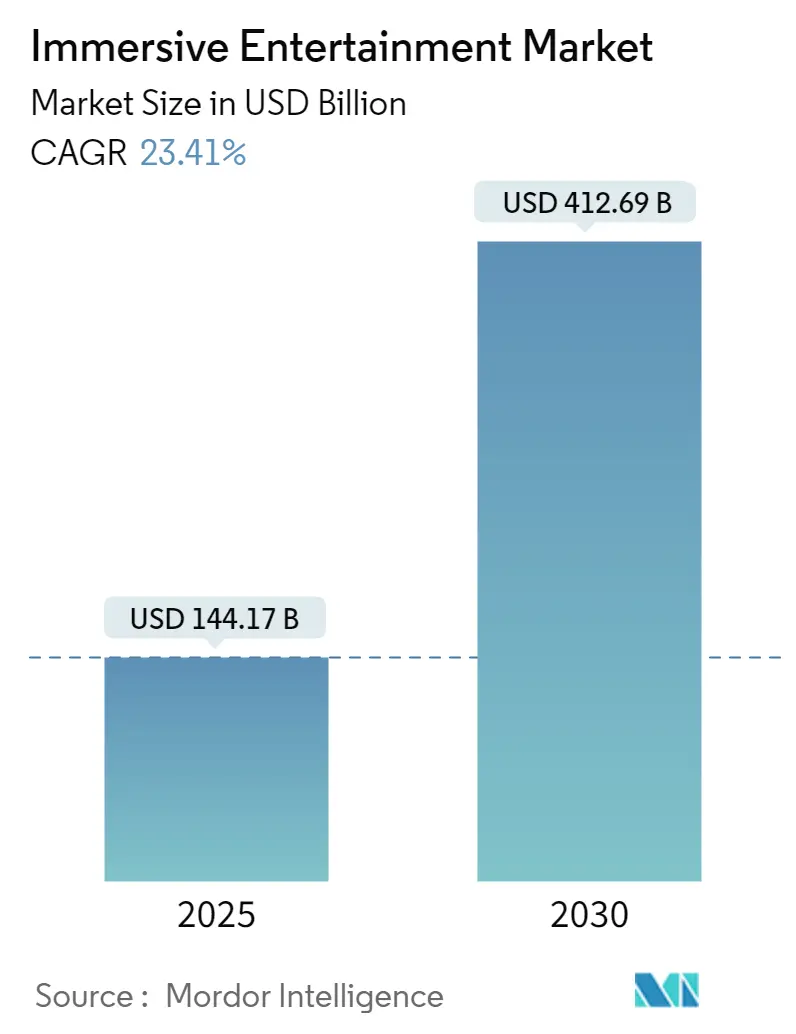
Immersive Entertainment Market Analysis
The Immersive Entertainment Market size is estimated at USD 144.17 billion in 2025, and is expected to reach USD 412.69 billion by 2030, at a CAGR of 23.41% during the forecast period (2025-2030).
- Advancements in technology, specifically in virtual and augmented reality, are propelling the growth of the immersive entertainment market. These advancements elevate the quality of immersive experiences and make them more accessible. These technologies have become more affordable and user-friendly with enhanced hardware and software, drawing in a wider audience.
- There is a surge in the consumer demand for unique and engaging experiences throughout the world. With a growing demand for entertainment transcending passive consumption, audiences gravitate toward immersive experiences. This shift is especially augmented among younger generations, who prioritize innovation and novelty in their entertainment selections.
- The gaming industry's expansion has significantly boosted the popularity of VR and AR experiences. As housing developers build more sophisticated and immersive content, these technologies find broader appeal. Furthermore, their integration into theme parks, museums, and live events underscores their growing prominence in various entertainment sectors. Major tech companies and content creators, backed by significant investments, are driving innovation and development, consistently delivering new and captivating immersive entertainment options.
- In July 2024, Layered Reality, the UK's immersive entertainment firm, entered a strategic partnership with Technicolor Group, renowned for its worldwide network of BAFTA and Academy visual effects studios. Technicolor's advertising and experience studio, The Mill, headquartered in London with offices spanning Paris, New York, LA, Seoul, Shanghai, and Bangalore, would spearhead the partnership.
- In August 2024, Super League, a firm focused on transforming the gaming industry into a media channel, joined forces with Meta-Stadiums, an innovative platform for creating and managing virtual stadiums in the metaverse. This strategic partnership aims to merge their strengths, delivering cross-platform immersive experiences and events tailored for music artists, sports teams, entertainment firms, and consumer brands. This alliance establishes a provider of metaverse programs and strategies, extending its reach across the virtual universe. Their offerings span from custom 3D spaces to leading immersive platforms, including Roblox, Fortnite Creative, The Sandbox, Decentraland, and Minecraft.
- However, high development and hardware costs, limited content availability, technical challenges, and user discomfort with VR/AR devices are restricting the growth of the market. Moreover, the demand for ample space and the public's gradual embrace of emerging technologies presents notable challenges.
Immersive Entertainment Market Trends
Increasing Consumer Demand in Gaming Entertainment is Driving the Market Growth Opportunities
- Surging consumer demand is a primary catalyst propelling the expansion of the immersive entertainment market worldwide. With a growing demand for distinctive and captivating experiences, consumers frequently find conventional entertainment methods lacking. Immersive entertainment spanning virtual reality (VR), augmented reality (AR), and mixed reality (MR) presents interactive and dynamic options, captivating a wide-ranging audience.
- Young consumers increasingly favor new and innovative entertainment choices. Their attraction lies in the personalized and immersive interaction with content. As a result, content creators and tech developers are now prioritizing these immersive experiences in their offerings.
- Moreover, the pandemic has hastened this shift. With restrictions on in-person gatherings, individuals turned to digital and remote entertainment options in greater numbers. During lockdowns, virtual experiences emerged as vital avenues for social interaction and entertainment, bolstering their popularity and acceptance.
- Demand for VR and AR games has surged in the gaming industry, fuelling increased investment and development in these technologies. Additionally, sectors like live events, theme parks, and museums are integrating immersive technologies, broadening the market's reach and allure. With consumer demand on the rise, the immersive entertainment market is set for continued expansion.
- According to the Game Developers Conference, the gaming landscape is evolving swiftly, with virtual reality and augmented reality gaming firmly establishing their presence. In a 2024 survey, 34% of global game developers reported actively creating titles for the Meta Quest Store.
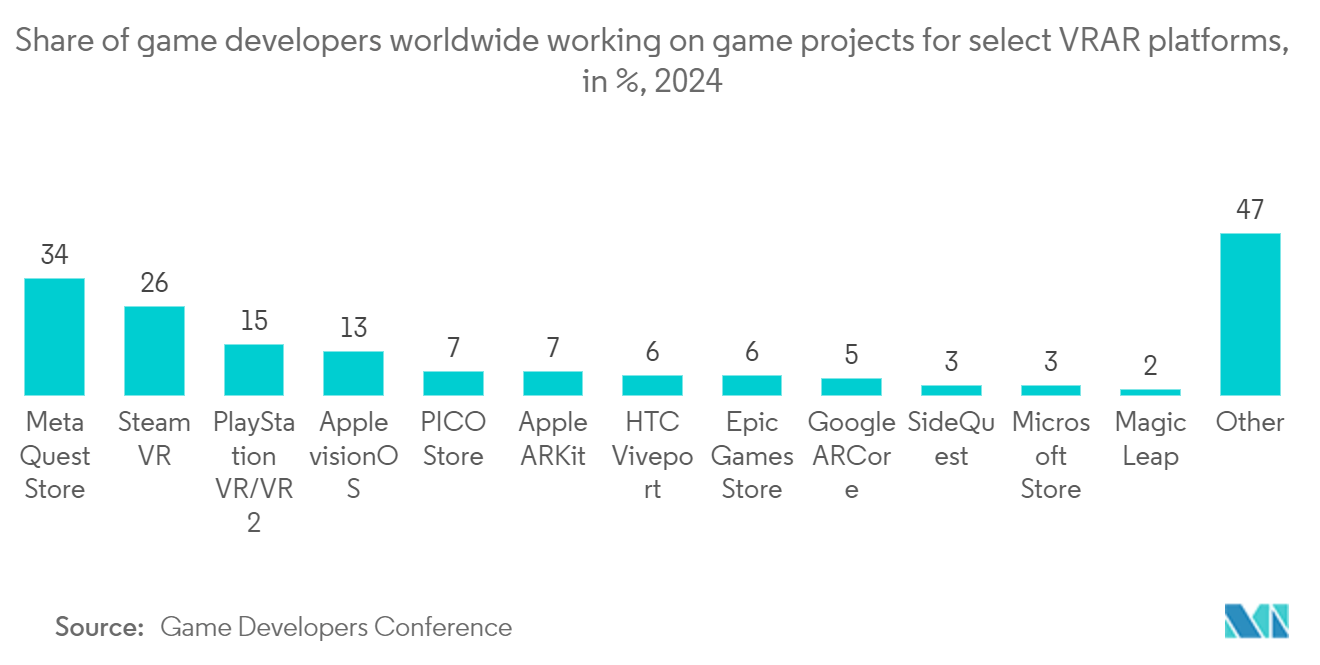
North America is Expected to Hold a Major Market Share
- In North America, the immersive entertainment market thrives on technological innovations, substantial investments in AR and VR, and a robust presence in the tech industry. Notably, there's a rising consumer demand for unique, interactive experiences, particularly encouraged by younger audiences.
- The gaming industry's growth, coupled with the adoption of immersive technologies in areas such as theme parks and live events, drives the market forward. Furthermore, the pandemic hastened the shift toward digital entertainment, amplifying the demand for immersive experiences. Significant investments from leading tech firms also fuel ongoing innovation and advancements in this domain.
- In North America, rising consumer spending power and the accessibility of budget-friendly VR headsets and compatible smartphones have spurred the adoption of immersive technologies. Furthermore, the introduction of 5G networks in the US and Canada offers essential bandwidth and low latency, ensuring smooth immersive experiences and driving further market growth.
- North America's headquarters for tech giants such as Apple, Microsoft, and Meta foster swift innovation in immersive entertainment solutions. Regional governments bolster the immersive entertainment industry with funding and supportive policies. North America's vast talent pool in computer graphics, game development, and virtual reality fuels the industry's innovation.
- In May 2024, Superplastic, an IP factory renowned across animated entertainment, music, fashion, and collectible art toys, forged a strategic alliance with AREA15, a provider of immersive entertainment. This collaboration marks the debut of Superplastic's animated characters in real life (IRL). As part of the partnership, Superplastic is set to unveil an experiential space in the AREA15 entertainment district later this year. This venture promises to introduce a new experience, seamlessly merging Superplastic's signature mischief and playfulness with art, hype culture, and fashion elements.
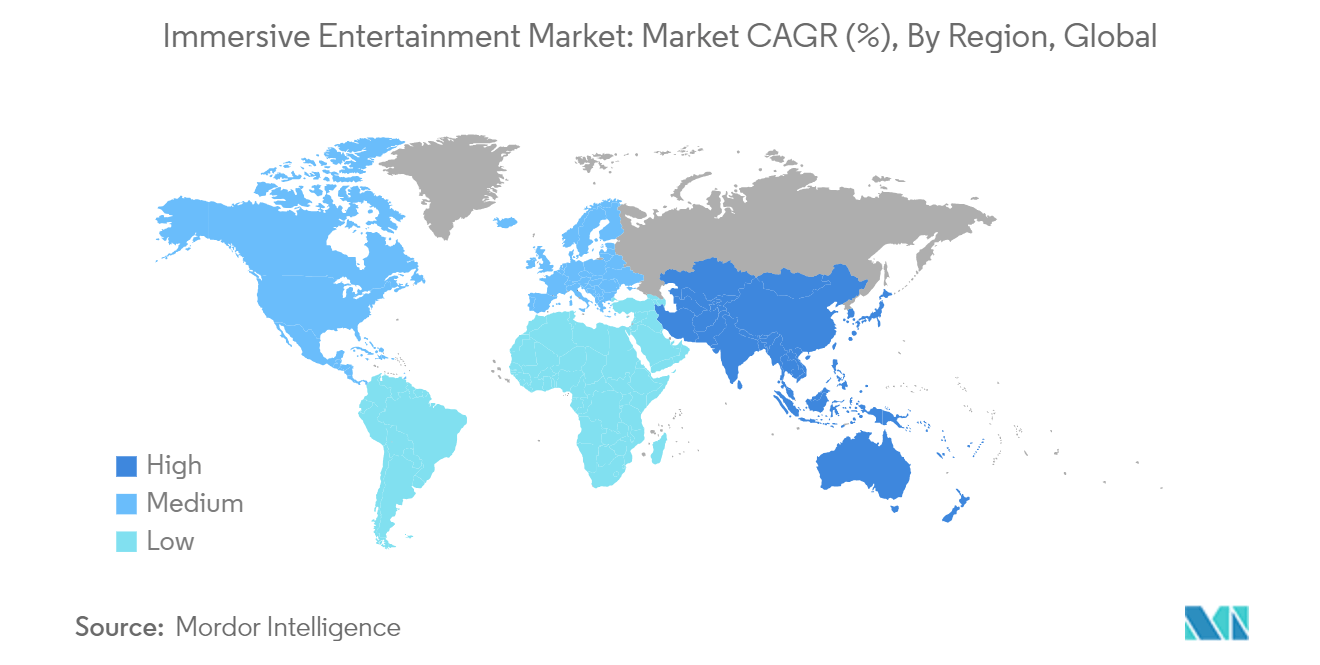
Immersive Entertainment Industry Overview
The immersive entertainment market is moderately fragmented and consists of several major players. The major market players with a prominent share in the market, such as teamLab, Meow Wolf, Secret Cinema, and Culturespaces, are centering on increasing their customer base through the adoption of various technologies.
- July 2024: Cosm, a provider of immersive technology, media, and entertainment, has successfully secured over USD 250 million in funding. This capital would fuel the long-term expansion of its "Shared Reality" venues and bolster its technology and media divisions. Cosm recently inaugurated its first venue in Los Angeles, Hollywood Park.
- May 2024: iQIYI, an online entertainment platform in China, was set to debut a VR immersive theater on the first floor of Galaxy Promenade in Galaxy Macau. The theater is based on iQIYI's popular series, "Love Between Fairy and Devil." This move underscores iQIYI's dedication to broadening its footprint in location-based entertainment, leveraging its distinctive 'IP+ Technology' approach.
Immersive Entertainment Market Leaders
-
teamLab
-
Meow Wolf
-
Secret Cinema
-
Culturespaces
-
Museum of Ice Cream
- *Disclaimer: Major Players sorted in no particular order
Immersive Entertainment Market News
- August 2024: Disney+ introduced a new immersive experience from National Geographic on its Apple Vision Pro app. Subscribers can now visually explore Iceland’s Thingvellir National Park through this feature. National Geographic has launched its inaugural immersive project tailored for Apple Vision Pro. Collaborating closely with Disney Studio Technology, National Geographic spearheaded this immersive environment's creative development and production. It utilized high-resolution 3D models captured on-site through photogrammetry alongside gigapixel panoramas.
- May 2024: Technicolor Group accelerated its expansion in experiential entertainment, building on its legacy of innovation and bolstering its dedicated team. This strategic decision aligns with the surging demand for experiential entertainment, extending beyond traditional theme parks to encompass museums, retail, marketing, travel, sports, and recreation.
Immersive Entertainment Industry Segmentation
Immersive entertainment captivates the senses and mind, fostering a genuine sense of presence in virtual or augmented realms. Leveraging technologies like virtual reality (VR), augmented reality (AR), and interactive environments, it seamlessly intertwines physical and digital elements. The study tracks the revenue generated through Immersive Entertainment. The industry incorporates diverse sectors, from themed entertainment and haunted attractions to virtual, augmented, and mixed-reality experiences. It also includes transmedia, escape rooms, immersive theatre, alternate reality games, live-action role-playing, themed dining establishments, and experimental marketing activations, along with experimental museums.
The Immersive Entertainment Market is segmented by application (themed entertainment, haunted attractions and escape rooms, immersive theatre, experiential art museums, and other applications (including exhibitions, etc.)) and geography (North America, Europe, Asia-Pacific, Australia, New Zealand, and the Rest of the World). The market size and forecasts are provided in terms of value (USD) for all the above segments.
| Application | Themed Entertainment |
| Haunted Attractions and Escape Rroms | |
| Immersive Theatres | |
| Experiential Art Museums | |
| Other Applications (Includes Exhibitions, etc.) | |
| Geography*** | North America |
| Europe | |
| Asia | |
| Australia and New Zealand | |
| Latin America | |
| Middle East and Africa |
Immersive Entertainment Market Research FAQs
How big is the Immersive Entertainment Market?
The Immersive Entertainment Market size is expected to reach USD 144.17 billion in 2025 and grow at a CAGR of 23.41% to reach USD 412.69 billion by 2030.
What is the current Immersive Entertainment Market size?
In 2025, the Immersive Entertainment Market size is expected to reach USD 144.17 billion.
Who are the key players in Immersive Entertainment Market?
teamLab, Meow Wolf, Secret Cinema, Culturespaces and Museum of Ice Cream are the major companies operating in the Immersive Entertainment Market.
Which is the fastest growing region in Immersive Entertainment Market?
Asia Pacific is estimated to grow at the highest CAGR over the forecast period (2025-2030).
Which region has the biggest share in Immersive Entertainment Market?
In 2025, the North America accounts for the largest market share in Immersive Entertainment Market.
What years does this Immersive Entertainment Market cover, and what was the market size in 2024?
In 2024, the Immersive Entertainment Market size was estimated at USD 110.42 billion. The report covers the Immersive Entertainment Market historical market size for years: 2019, 2020, 2021, 2022, 2023 and 2024. The report also forecasts the Immersive Entertainment Market size for years: 2025, 2026, 2027, 2028, 2029 and 2030.
Immersive Entertainment Industry Report
Statistics for the 2025 Immersive Entertainment market share, size and revenue growth rate, created by Mordor Intelligence™ Industry Reports. Immersive Entertainment analysis includes a market forecast outlook for 2025 to 2030 and historical overview. Get a sample of this industry analysis as a free report PDF download.

